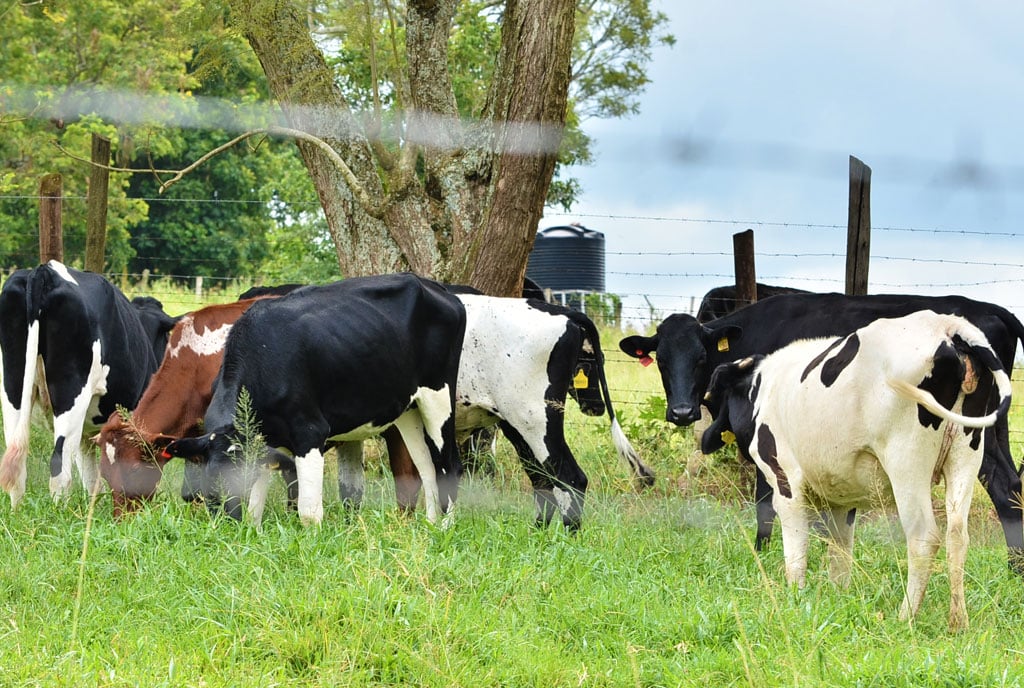Prime
Conservation practices on dairy farms

Exotic cows grazing at MbaZardi Farm in Mbarara. Sustainability should be at the heart of dairy farming operations. PHOTO/GEORGE KATONGOLE
What you need to know:
- Prioritising a sustainable future should be the primary concern for every dairy farmer, motivating them to implement measures aimed at minimising their carbon footprint.
- By investing in sustainable dairy farming practices, farmers can uphold their family legacies and pave the way for a new generation.
- This entails focusing on maintaining healthy soil, ensuring clean water, and harnessing renewable energy sources.
The dairy sector must actively participate in the global effort to mitigate the impacts of climate change. One effective approach is to reduce the greenhouse gas (GHG) emissions associated with cattle, thereby creating a lower carbon footprint.
The annual milk production report reveals a substantial increase in litres, rising from approximately 1.9 billion to about 3.2 billion by 2022, according to the Food and Agriculture Organisation (FAO).
A 2019 FAO report also links an increase in animal numbers to higher levels of absolute emissions. The study explains that the sector’s GHG emissions grew by 18 percent between 2005 and 2015 due to a 30 percent overall growth in milk production, driven by increased consumer demand.
Experts in the field propose dairy farming practices to encourage a low-carbon future and environmental protection.
Feeding
Dr Victor Yamo, from World Animal Protection, advocates for a diet for dairy animals that utilises minimal amounts of concentrates, especially in regions such as Africa where natural pastures dominate.
“With growing demand for animal products due to an increasing population and urbanization we run the risk of intensifying the dairy production systems leading to an increase in GHGs emissions,” he says.
Dr Andrew Atuhaire, a senior researcher at the National Agricultural Research Organisation (Naro), recommends incorporating nutritional supplements in animal feeds to enhance feed efficiency, disease resistance, and adaptability to climatic conditions.
Manure management
Cattle consume food and excrete waste in the form of manure. Farmers should consider manure as a byproduct of digested food. Dairy manure, far from being a waste, is a valuable resource with diverse applications. It acts as a natural fertiliser, promoting crop growth to produce feed for the cows.
Additionally, this manure can be converted into renewable energy, providing power for the farm.
In terms of manure management, experts emphasise practices that preserve nature.
Hakim Baliraine, the National Chairperson at The Eastern and Southern Africa Small-Scale Farmers Forum (ESAFF), suggests using animal waste to create manure for agro-ecological approaches.
This includes using urine and droppings as fertilisers for healthy crop growth and even generating biogas from these wastes.
Relatedly, storage areas for waste, including manure heaps, slurry stores, and farm dumps, should be strategically located, taking into account local amenities in terms of sight and smell, as well as the potential environmental risks associated with pollution and vermin.
It is essential to conduct regular inspections of permanent slurry stores and manure heaps to identify any signs of leaks or structural issues, thereby minimising the risk of runoff that could pollute the environment.
Proper disposal practices should be followed for other wastes such as waste milk, dead livestock, plastic silage wrap, farm chemicals, and fertilisers to prevent environmental pollution and mitigate potential disease issues. Eliminating potential breeding sites for flies and other disease-carrying vermin is crucial.
To enhance waste management, a straightforward plan should be developed to outline when, where, and at what rate to spread manures, slurry, and other organic wastes, aiming to minimise the risk of causing pollution.
Energy efficiency
Farmers should actively seek options to safeguard the environment. Approximately 15% of agricultural production costs are attributed to energy-related expenses, and with the escalation of energy prices, these costs become an increasingly substantial portion of farm budgets. The most efficient, economical, and environmentally friendly approach to curbing these expenses is through the enhancement of energy efficiency.
Farms utilise energy in various forms, with electricity, fuel, and natural gas being the primary sources.
Jacob Etunganan, an energy consultant with the Netherlands Development Organisation (SNV), suggests that incorporating renewable energy resources such as biogas or biomass can effectively reduce energy costs.
Implementing energy conservation practices, such as utilising LED lights and solar panels to power the farm, not only contributes to cost savings but also aids in lowering the temperature of milk. This dual benefit results in reduced refrigeration needs, and the warmed water generated in the process can be repurposed for tasks like providing drinking water for cows or cleaning barns, further promoting sustainable energy usage on farms.
Rotation of pastures
Pasture rotation is a fundamental component of grazing systems, playing a pivotal role in weed and pest control and optimising nutrient utilisation.
According to Dr Halid Kirunda, the director of Mbarara Zonal Agricultural Research and Development Institute (MbaZARDI), this approach not only enhances soil quality but also contributes to the enrichment of organic matter in the soil through the decomposition of manure from grazing animals.
The resulting organic matter becomes a valuable resource for plants.
He says that pasture rotation proves to be an effective strategy for maintaining the fertility and health of the land, ensuring the well-being of your herd. Regularly shifting livestock through paddocks serves to prevent boredom among the animals and diminishes the likelihood of disease or injury, promoting overall herd happiness and health.
Protecting the environment
Dairy farmers are encouraged to implement practices that prevent the risk of contaminating the surrounding environment. Storage units for oil, silage liquor, soiled water, and other potentially polluting substances should be situated in secure locations, and preventive measures must be in place to avoid accidents leading to the pollution of local water sources. It is essential to refrain from disposing of agricultural or veterinary chemicals in areas where there is a potential for them to enter the local environment.
Soil health practices
Maintaining healthy soil is imperative for dairy farmers to cultivate crops and ensure a sustainable source of feed for their cows. To protect the soil during periods when the primary crops are not growing, dairy farmers are encouraged to plant cover crops, which serve as a protective layer.
According to Joshua Aijuka, an agroecologist at Participatory Ecological Land Use Management (PELUM) Uganda, “Both restoring and maintaining soil health are essential to making agriculture viable in the long-term.”
Additionally, the adoption of no-till practices, a form of conservation tillage, maintains the land’s structure.
Storage
Relatedly, storage areas for waste, including manure heaps, slurry stores, and farm dumps, should be strategically located, taking into account local amenities in terms of sight and smell, as well as the potential environmental risks associated with pollution and vermin.
It is essential to conduct regular inspections of permanent slurry stores and manure heaps to identify any signs of leaks or structural issues, thereby minimising the risk of runoff that could pollute the environment.





